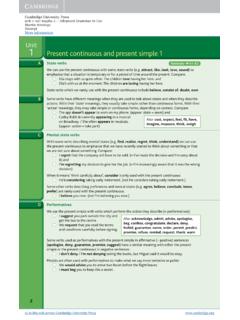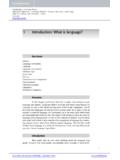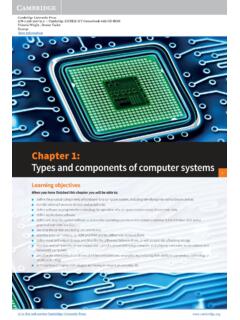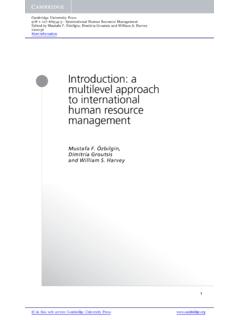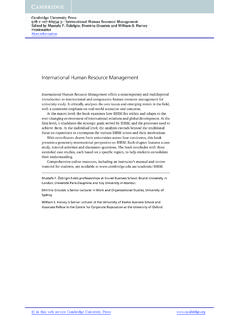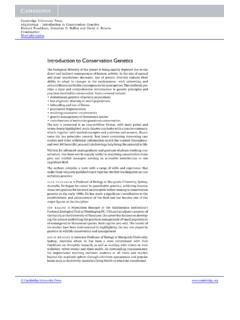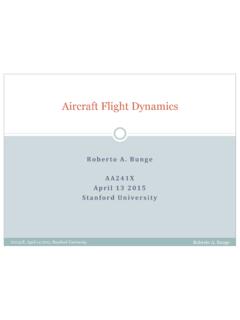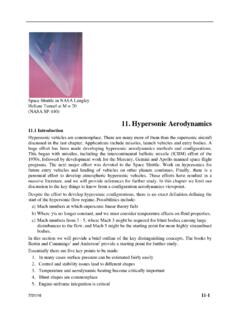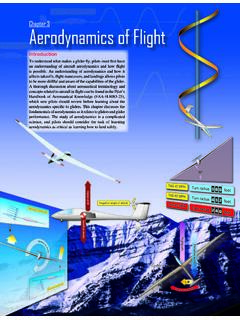Transcription of Principles of Helicopter Aerodynamics
1 Principles of Helicopter AerodynamicsSecond EditionThe Helicopter is truly a unique form of aircraft and a mastery of modern aeronau-tical engineering that fulfills a variety of civilian and military roles. The usefulnessof the Helicopter lies in its unique ability to take off and land vertically on almost anyterrain, to hover stationary relative to the ground, and to fly forward, backward, orsideways. These unique flying characteristics, however, come at a price, includingcomplex aerodynamic problems, significant vibrations, high levels of noise, andrelatively large power requirements compared to a fixed-wing aircraft of the book, written by an internationally recognized teacher and researcher inthe field, provides a thorough, modern treatment of the aerodynamic principlesof helicopters and other rotating-wing vertical lift aircraft such as tilt-rotors andautogiros.
2 The first part of the text begins with a unique technical history of he-licopter flight and then covers basic methods of rotor aerodynamic analysis andrelated issues associated with the performance of the Helicopter and its aerody-namic design. The second part is devoted to more advanced topics in helicopteraerodynamics, including airfoil flows, unsteady Aerodynamics , dynamic stall, ro-tor wakes and rotor airframe aerodynamic interactions. The third part of the bookcontains chapters on autogiros and advanced methods of Helicopter aerodynamicanalysis. A companion chapter on the Aerodynamics of wind turbines recognizesboth the commonalities and differences with the aerodynamic problems found onhelicopters. Every chapter is extensively illustrated and concludes with a compre-hensive bibliography and a set of homework undergraduate and graduate students, as well as practicing engineersand researchers, will welcome this thorough and up-to-date text on the principlesof Helicopter and rotating-wing J.
3 Gordon Leishman is the Minta Martin Chair of Engineering and Professorof Aerospace Engineering at the University of Maryland. He is a former aero-dynamicist at Westland Helicopters and has written extensively on topics in heli -copter Aerodynamics . Dr. Leishman is a Fellow of the Royal Aeronautical Societyand an Associate Fellow of the American Institute of Aeronautics & is also the Editor-in-Chief for theJournal of the American Helicopter Cambridge University PressCambridge University Press0521858607 - Principles of Helicopter Aerodynamics , Second EditionJ. Gordon LeishmanFrontmatterMore informationCambridge Aerospace SeriesEditorsWe i S h y yandMichael J. Rycroft1. Rolfe and Staples (eds.):Flight Simulation2. P. Berlin:The Geostationary Applications Satellite3. Smith:Aircraft Noise4. Vinh:Flight Mechanics of High-Performance Aircraft5.
4 Mair and Birdsall:Aircraft Performance6. Abzug and Larrabee:Airplane Stability and Control7. Sidi:Spacecraft Dynamics and Control8. Anderson:A History of Aerodynamics9. Cruise, Bowles, Goodall, and Patrick: Principles of SpaceInstrument Design10. Khoury and Gillett (eds.):Airship Technology11. J. Fielding:Introduction to Aircraft Design12. Leishman: Principles of Helicopter Aerodynamics13. J. Katz and A. Plotkin:Low Speed Aerodynamics , 2nd Edition14. Abzug and Larrabee:Airplane Stability and Control: A History ofthe Technologies that Made Aviation Possible, 2nd Edition15. Hodges and Pierce:Introduction to Structural Dynamics andAeroelasticity16. W. Fehse:Automatic Rendezvous and Docking of Spacecraft17. Flack:Fundamentals of Jet Propulsion with Applications18. Leishman: Principles of Helicopter Aerodynamics , 2nd Edition19.
5 Baskharone: Principles of Turbomachinery in Air-Breathing Cambridge University PressCambridge University Press0521858607 - Principles of Helicopter Aerodynamics , Second EditionJ. Gordon LeishmanFrontmatterMore informationPrinciples of HelicopterAerodynamicsSecond EditionJ. GORDON LEISHMAN, (Eng.), , of Cambridge University PressCambridge University Press0521858607 - Principles of Helicopter Aerodynamics , Second EditionJ. Gordon LeishmanFrontmatterMore informationCAMBRIDGE UNIVERSITY PRESSC ambridge, New York, Melbourne, Madrid, Cape Town, Singapore, S o PauloCambridge University Press40 West 20th Street, New York, NY 10011-4211, on this title: Cambridge University Press 2006 This publication is in copyright. Subject to statutory exceptionand to the provisions of relevant collective licensing agreements,no reproduction of any part may take place withoutthe written permission of Cambridge University published 2000 Reprinted with corrections 2001, 2002, 2003 Second edition 2006 Printed in the United States of AmericaA catalog record for this publication is available from the British of Congress Cataloging in Publication DataLeishman, J.
6 Of Helicopter Aerodynamics / J. Gordon Leishman. 2nd cm. (Cambridge aerospace series)Includes bibliographical references and 0-521-85860-7 (hardback)1. Helicopters Aerodynamics . I. Title. II. 352 dc222005025467 ISBN-13 978-0-521-85860-1 hardbackISBN-10 0-521-85860-7 hardbackCambridge University Press has no responsibility forthe persistence or accuracy of URLs for external orthird-party Internet Web sites referred to in this publicationand does not guarantee that any content on suchWeb sites is, or will remain, accurate or Cambridge University PressCambridge University Press0521858607 - Principles of Helicopter Aerodynamics , Second EditionJ. Gordon LeishmanFrontmatterMore informationTO MY STUDENTSin appreciation of all they have taught Cambridge University PressCambridge University Press0521858607 - Principles of Helicopter Aerodynamics , Second EditionJ.
7 Gordon LeishmanFrontmatterMore informationContentsPreface to the Second EditionpagexixPreface to the First EditionxxiiiAcknowledgmentsxxviiList of Main Symbolsxxxi1 Introduction: A History of Helicopter Technical Problems in Attaining Vertical First Quite a : A Key Enabling the Verge of The First Toward Mass Maturing Compounds, Tilt-Wings, and Chapter Questions50 Bibliography512 Fundamentals of Rotor Theory Analysis in Hovering Near a Hovering Laws of to a Hovering Loading and Power Inflow and Power of Theory with Measured Rotor Effects on Rotor of Nonideal Effects from Rotor Induced Tip Rotor Solidity and Blade Loading Power Cambridge University PressCambridge University Press0521858607 - Principles of Helicopter Aerodynamics , Second EditionJ.
8 Gordon LeishmanFrontmatterMore Momentum Analysis in Axial Climb and Axial Axial Region between Hover and Windmill Power Required in Axial Climbing and Descending Four Working States of the Rotor in Axial Vortex Ring Momentum Analysis in Forward Induced Velocity in Forward Special Case, = Numerical Solution to Inflow General Form of the Inflow Validity of the Inflow Rotor Power Requirements in Forward Other Applications of the Momentum Coaxial Rotor Tandem Rotor Chapter Questions110 Bibliography1133 Blade Element Element Analysis in Hover and Axial Rotor Thrust and Power Element Momentum Theory (BEMT) Radial Distributions of Inflow on the Inflow : Numerical of Inflow and of Swirl Optimum Hovering Theory of Estimates for the Prandtl s Tip-Loss Blade Design and Figure of BEMT in Climbing Further Comparisons of BEMT with Compressibility Corrections to Rotor Blade Chords and Weighted Wing Weighted Torque Weighted Solidity of the Optimum Cambridge University PressCambridge University Press0521858607 - Principles of Helicopter Aerodynamics , Second EditionJ.
9 Gordon LeishmanFrontmatterMore Solidities of Tapered Lift Element Analysis in Forward Blade of the Approximate Induced Velocity Rotating Blade of about the Flapping about the Lead Lag of Motion for a Flapping Description of Blade Flapping Flapping Harmonics of Blade of Blade Flapping with a Hinge Feathering and the of Rotor Reference Dynamics of a Lagging Blade with a Hinge Coupled Flap Lag Coupled Pitch Flap Other Types of Teetering Semi-Rigid or Hingeless Introduction to Rotor Equations for Free-Flight Typical Trim Solution Procedure for Level Chapter Questions209 Bibliography2115 Helicopter International Standard and Axial Climb Flight Profile Losses and Tip Rotor Cambridge University PressCambridge University Press0521858607 - Principles of Helicopter Aerodynamics , Second EditionJ.
10 Gordon LeishmanFrontmatterMore of Gross of Density Fuel for Minimum for Maximum Payload and Endurance Payload Altitude or Factors Affecting Maximum Attainable Forward Performance of Coaxial and Tandem Dual in Forward Velocity (H V) Ring State (VRS) of VRS of VRS on Flight Flight Near the Flight Near the in Maneuvering Factors Influencing Performance Chapter Questions272 Bibliography2736 aerodynamic Design of Design and Preliminary Design of the Main of Planform and Tip Study: The BERP aerodynamic Design Drag and Download Drag Cambridge University PressCambridge University Press0521858607 - Principles of Helicopter Aerodynamics , Second EditionJ. Gordon LeishmanFrontmatterMore of Wind Tunnels in aerodynamic of Tail Stall Pushers versus Tractors Tail Rotor Other Anti-Torque NOTAR High-Speed Compound Other High-Speed Smart Rotor Human-Powered Hovering Micro Air Chapter Questions338 Bibliography3407 Aerodynamics of Rotor Rotor Airfoil Number and Mach Number of the Boundary Rotor Similarity Shape Pressure Pressure of Chordwise of Chordwise of a Representative Airfoil of Distributed Force and Moment Moment and Related of of Airfoil Shape on Pitching of Trailing Edge Cambridge University PressCambridge University Press0521858607 - Principles of Helicopter Aerodynamics , Second EditionJ.

